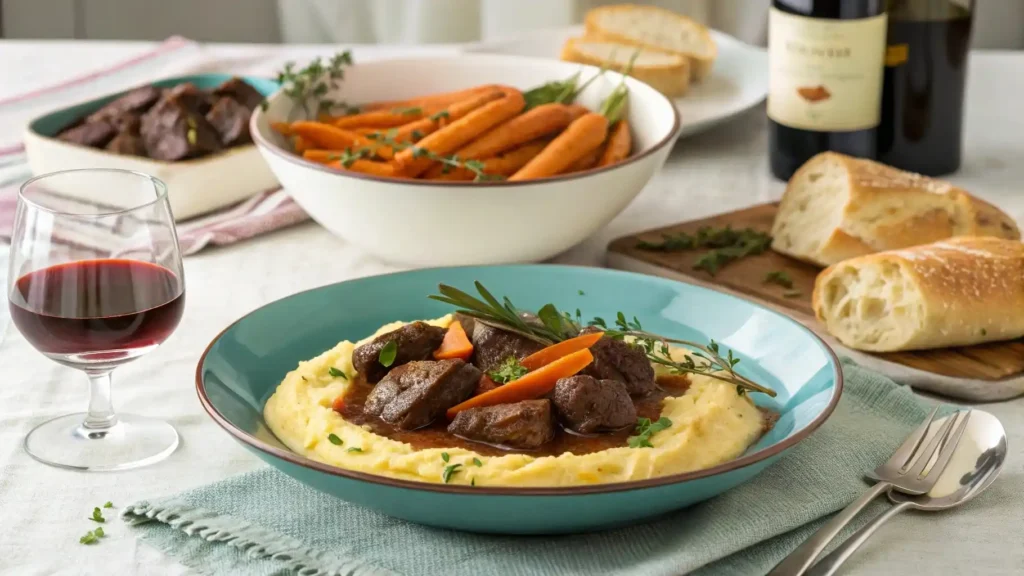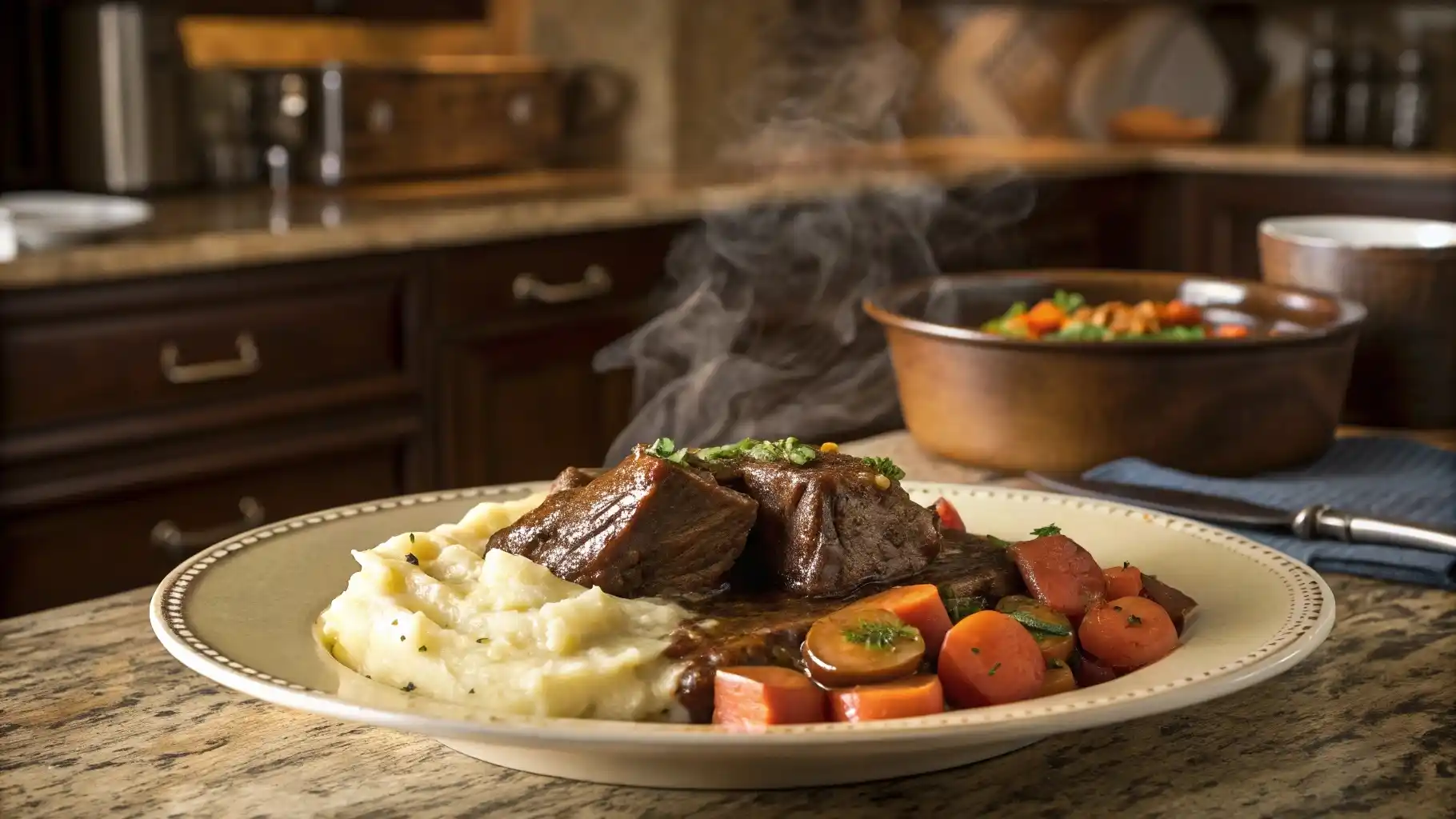Braised beef is a dish that feels like a warm hug on a chilly evening. With its melt-in-your-mouth tenderness and rich, savory flavor, it’s no wonder this classic cooking technique has been cherished across cultures for centuries. In this guide, we’ll dive deep into the world of braised beef. You’ll learn what makes this dish so special, the best cuts of beef to use, and step-by-step instructions to achieve perfection. Along the way, we’ll share helpful tips, popular recipes, and even answer your burning questions about braising. Whether you’re a seasoned cook or a beginner in the kitchen, this guide has everything you need to make a memorable braised beef dinner.
What Is Braised Beef?
Definition of Braised Beef
Braised beef is a slow-cooked dish where tougher cuts of beef are simmered in liquid until tender. The process typically involves searing the meat to lock in flavor, followed by cooking it in a flavorful liquid like broth, wine, or a combination of the two. The result? A deeply flavorful, fall-apart tender beef dish that feels like it came straight from a cozy family kitchen.
Origins and History of Braising Techniques
Braising has roots in ancient cooking traditions. The French term braiser refers to cooking meat in a covered pot with liquid, but cultures worldwide have their own versions of braising. From European stews to Asian-style braised meats, this method has been celebrated for its ability to turn inexpensive cuts of meat into gourmet-quality meals. It’s a cooking style that emphasizes patience and care, making it both a practical and emotional experience.
Why Braising Makes Beef Tender and Juicy
The secret to braised beef’s tenderness lies in the low-and-slow cooking process. Tough cuts of meat, like chuck or brisket, are packed with collagen. When cooked slowly, this collagen breaks down into gelatin, creating a silky, moist texture. Plus, the meat absorbs the flavors of the cooking liquid, aromatics, and spices, resulting in a dish that’s as rich in taste as it is in texture.
The Best Cuts for Braised Beef
Top Cuts of Beef for Braising: Chuck, Brisket, and More
Not all cuts of beef are created equal when it comes to braising. The best choices are those tough, well-marbled cuts that might seem less appealing at first glance. Chuck roast is a favorite for braised beef thanks to its generous marbling and connective tissue, which transform into rich, velvety goodness when cooked low and slow. Brisket, with its deep, beefy flavor, is another excellent option. Short ribs, shanks, and oxtail also shine in braising recipes, bringing their own unique textures and flavors to the dish.
Why Tougher Cuts Work Best
It might seem counterintuitive, but tougher cuts of beef are perfect for braising because they contain a higher amount of connective tissue, including collagen. When cooked slowly, this collagen breaks down into gelatin, giving the dish its signature moistness and luxurious texture. Leaner cuts like sirloin or tenderloin simply don’t have enough fat or connective tissue to hold up during the braising process, often resulting in dry or bland meat.
How to Choose the Perfect Cut of Beef for Braising
When shopping for beef to braise, look for cuts with visible marbling. These streaks of fat are your ticket to a juicy, flavorful dish. It’s also worth noting that bone-in cuts, like shanks or short ribs, can add an extra layer of depth to the final dish, as the marrow enriches the cooking liquid. Don’t be afraid to ask your butcher for recommendations they’ll often have insider tips on the best cuts for braising!
Step-by-Step Guide to Braising Beef
Preparation: Seasoning and Searing

The key to any great braised beef dish starts with proper prep. Begin by seasoning your beef generously with salt and pepper. This simple step enhances the flavor of the meat and helps create a beautiful crust during searing. Heat a heavy-bottomed pot, like a Dutch oven, with a drizzle of oil until it’s hot but not smoking. Add the beef and sear it on all sides until golden brown. This step isn’t just for looks it develops a rich, caramelized flavor base that takes the dish to the next level.
The Importance of Searing for Flavor
Searing is non-negotiable in braising. When you brown the beef, you’re creating what’s called the Maillard reaction a process that builds complex flavors and aromas. Without this step, your braised beef may lack depth, no matter how flavorful your cooking liquid is.
Simmering in Liquid: Broth, Wine, and Aromatics
Once the meat is seared, it’s time to build the braising liquid. Classic options include beef broth, red wine, or even a combination of the two. Don’t skimp on the aromatics think garlic, onions, carrots, celery, and fresh herbs like rosemary or thyme. These elements infuse the liquid (and the beef!) with irresistible flavor. Pour enough liquid to partially submerge the meat, then bring it to a gentle simmer.
Cooking Time: Low and Slow
Braising is all about patience. Cover the pot and cook the beef over low heat, either on the stovetop or in the oven at around 325°F (160°C). Cooking times vary depending on the cut, but generally, it takes 2 to 3 hours for the meat to become fork-tender. Check occasionally to ensure the liquid hasn’t evaporated too much, adding more broth or wine if necessary.
With these steps, you’re well on your way to creating a batch of braised beef that’s flavorful, tender, and utterly satisfying. Next, we’ll explore some popular recipes you can try!
Popular Braised Beef Recipes
Classic Red Wine Braised Beef Recipe
If you’re looking for a timeless take on braised beef, the red wine version is unbeatable. Start by searing your beef and sautéing onions, garlic, and carrots in the same pot. Add red wine and beef broth, scraping the bottom of the pot to deglaze. Toss in fresh thyme, rosemary, and bay leaves, then let the beef simmer gently for hours until it’s fork-tender. Serve it over creamy mashed potatoes or buttery polenta for a meal that’s as comforting as it is elegant.
Asian-Style Braised Beef: Soy, Ginger, and Garlic
For a flavorful twist, try an Asian-inspired braised beef recipe. Swap out the wine for soy sauce and beef broth, and add ingredients like fresh ginger, garlic, star anise, and a splash of rice vinegar. As the beef cooks, these bold flavors infuse the meat, creating a dish that’s savory, slightly sweet, and irresistibly fragrant. Serve it with steamed jasmine rice or noodles for a complete meal.
Vegetable Pairings for Braised Beef
The beauty of braised beef is that it pairs beautifully with a variety of vegetables. Root vegetables like carrots, parsnips, and turnips are classic additions, as they hold their shape and absorb the rich flavors of the braising liquid. Mushrooms, pearl onions, and even hearty greens like kale or Swiss chard can also add texture and depth to your dish. Adding veggies directly into the pot not only enhances the dish but also makes cleanup easier bonus!
For more delicious recipes like this, explore our recipe collection for hearty, flavorful meals that the whole family will love.
Tips and Tricks for Perfect Braised Beef
Temperature and Timing Tips for Beginners
One of the most important tips for braised beef success is to keep the temperature low and consistent. Cooking at around 300-325°F (150-160°C) allows the beef to break down gradually without becoming dry. Avoid boiling the liquid, as it can toughen the meat. If you’re in a hurry, consider using a pressure cooker or slow cooker they’re great alternatives for achieving tender beef without sacrificing flavor.
How to Avoid Common Mistakes
Braising might seem simple, but a few missteps can ruin the dish. First, don’t skip the searing step. Without it, you’ll miss out on the deep, caramelized flavors that are key to a good braise. Second, be sure to add enough liquid to keep the beef partially submerged too little liquid can lead to dry, uneven cooking. Finally, resist the urge to check the beef too often. Opening the pot releases heat and slows the cooking process.
Enhancing Flavors with Herbs and Spices
The secret to unforgettable braised beef lies in layering flavors. Fresh herbs like thyme, rosemary, and parsley are classic choices, but don’t be afraid to experiment. Spices like smoked paprika, cumin, or even cinnamon can add depth and complexity. Adding a touch of acidity like a splash of vinegar or a squeeze of lemon juice at the end of cooking helps brighten the flavors and balance the richness of the dish.
With these tips, you’ll not only avoid common mistakes but also elevate your braised beef to restaurant-quality levels. Next up, we’ll tackle some frequently asked questions to address any lingering doubts!
FAQs About Braised Beef
How Long Should You Braise Beef?
Cooking times for braised beef can vary depending on the cut of meat and the method used. Generally, beef needs to braise for 2 to 3 hours in the oven or on the stovetop at a low temperature (around 300-325°F). For a slow cooker, plan for 6 to 8 hours on low heat. The key is patience cook the beef until it’s fork-tender. If it’s still tough, it likely needs more time to break down the connective tissue.
Can You Braise Beef in an Instant Pot?
Absolutely! The Instant Pot is a fantastic tool for speeding up the braising process while still delivering tender, flavorful beef. To braise in an Instant Pot, start by using the sauté function to sear the meat. Then, add your liquid and aromatics before sealing the lid. Cook on high pressure for 35 to 45 minutes, followed by a natural release. This method is perfect for busy weeknights when you’re short on time but craving braised beef.
What’s the Difference Between Braising and Roasting?
While both methods create delicious beef dishes, braising and roasting are quite different. Braising uses liquid to cook meat slowly, ensuring it stays moist and tender. In contrast, roasting is a dry-heat method where the meat cooks in an oven without added liquid, resulting in a crusty exterior. For tougher cuts, braising is your best bet to transform them into succulent, flavorful meals.
Pairing Braised Beef with Sides and Drinks

Best Sides to Serve with Braised Beef
Braised beef pairs beautifully with hearty sides that complement its rich flavors. Mashed potatoes are a classic choice, soaking up the savory juices like a sponge. Polenta is another fantastic option, offering a creamy base with a slightly nutty flavor. If you prefer something lighter, consider roasted vegetables, crusty bread, or a fresh green salad for balance.
Wine Pairings for Braised Beef
The bold flavors of braised beef call for equally bold wines. A robust red wine, like Cabernet Sauvignon, Merlot, or Syrah, is an excellent companion to the dish’s rich, savory notes. If you’ve used wine in your braising liquid, serving the same variety at the table creates a perfect pairing. Not a wine fan? A dark beer, like a stout or porter, can add a satisfying malty contrast to the meal.
How to Use Leftover Braised Beef
Leftover braised beef is a gift that keeps on giving. Shred it and mix it into pasta or tacos for a whole new meal. It also works wonderfully in sandwiches, paired with melted cheese and toasted bread. Another idea? Turn it into a hearty beef stew by adding potatoes, carrots, and more broth. With so many options, there’s no reason to let any of it go to waste!
With the right pairings and creative uses for leftovers, your braised beef meal can stretch far beyond the dinner table. Up next: we’ll explore the nutritional benefits of this delicious dish!
Nutritional Benefits of Braised Beef
Is Braised Beef Healthy?
Braised beef can absolutely be a part of a healthy diet when prepared thoughtfully. Beef is an excellent source of high-quality protein, which is essential for building and repairing tissues. It’s also rich in key nutrients like iron, zinc, and B vitamins, which support energy production and immune health. However, the overall nutritional value depends on the cut of beef you choose and the ingredients in your braising liquid. For a healthier option, leaner cuts like eye of round or top round can reduce the fat content without sacrificing flavor.
How to Make Braised Beef Lighter
If you’re looking to cut back on calories or fat, there are simple ways to lighten up braised beef. First, trim any visible fat from the meat before cooking. Opt for broth-based braising liquids instead of those heavy in wine or cream. Adding plenty of vegetables, such as carrots, celery, and tomatoes, not only boosts flavor but also increases the nutritional value of the dish. Finally, control portion sizes and pair your braised beef with wholesome sides like roasted vegetables or a simple salad for a balanced meal.
With these small adjustments, you can enjoy this comforting dish guilt-free while still reaping its nutritional benefits.
Variations on Braised Beef
- Korean-Style Braised Beef: Inspired by ground beef bulgogi, you can add soy sauce, ginger, and sesame oil for an Asian twist.
- Beef Stew with Noodles: Turn your braised beef into a soup by checking out this beef and noodle soup.
Perfect Side Dishes
Braised beef pairs wonderfully with a variety of sides. Here are some favorites:
- Creamy Mashed Potatoes – Try this Yukon Gold potatoes recipe for the ultimate side dish.
- Crusty Bread – Perfect for soaking up the delicious sauce.
- Steamed Vegetables – Adds freshness and balance to the meal.
People Also Ask (FAQs)
How many calories are in Olive Garden Grilled Chicken Margherita?
Olive Garden’s Grilled Chicken Margherita contains around 540 calories per serving. This dish, known for its zesty lemon and basil flavors, is lighter compared to many other Italian entrees. Pairing it with a side salad can create a balanced, satisfying meal.
How many calories are in a Margarita Grilled Chicken?
Margarita Grilled Chicken, often featured on Tex-Mex menus, contains about 600 calories per serving, depending on the recipe. This dish typically includes grilled chicken topped with cheese, pico de gallo, and avocado. To reduce calories, consider using low-fat cheese or skipping the avocado topping.
Should I Put Olive Oil on Chicken Before Grilling?
Yes, brushing chicken with olive oil before grilling helps prevent it from sticking to the grill. It also locks in moisture and enhances the flavor by creating a golden, caramelized crust. Just a light coating will do the trick!
What Toppings Go Well with Chicken?
Chicken is incredibly versatile, making it easy to pair with a variety of toppings. Popular options include sautéed mushrooms, caramelized onions, fresh herbs, or even a dollop of pesto. For a heartier dish, try melted cheese, crispy bacon, or a drizzle of barbecue sauce.
check out these related recipes:
- Looking for fresh meal inspiration? Salad Bowl: A Fresh Perspective On Unity Without Losing Identity pairs well with seafood.
- If you love bold flavors, don’t miss Pickle Pie Pizza is the Big Dill Everyone’s Talking About!.
- For the ultimate comfort food, check out Shells and Cheese Secrets: Melt-in-Your-Mouth Goodness Every Time.

